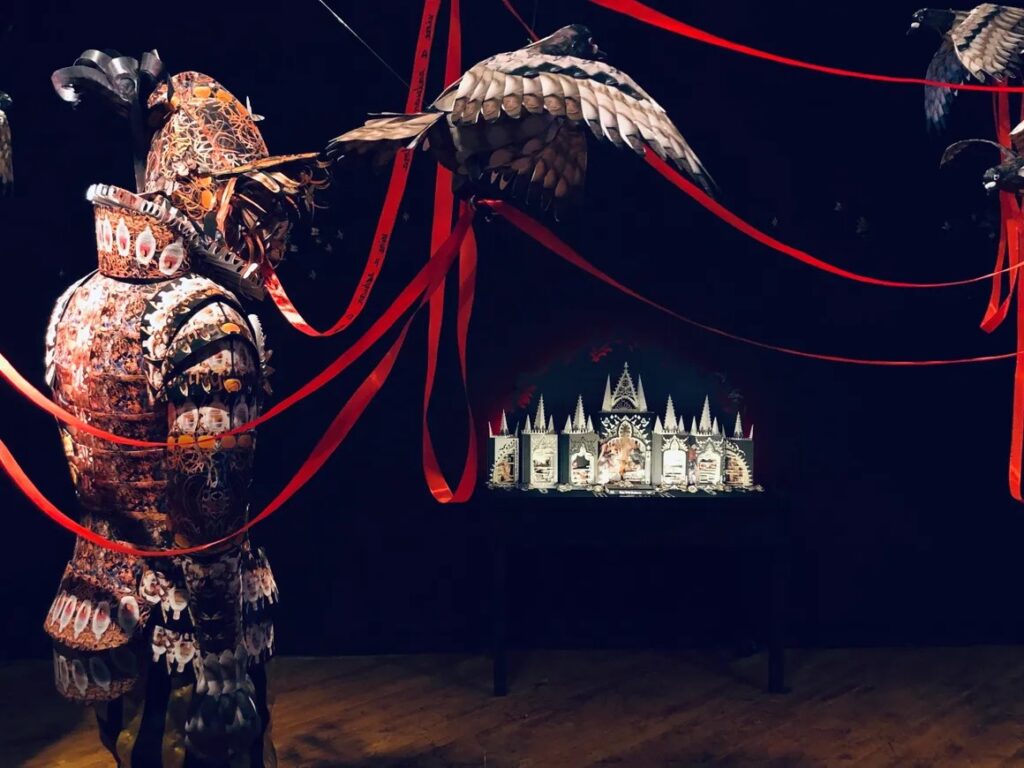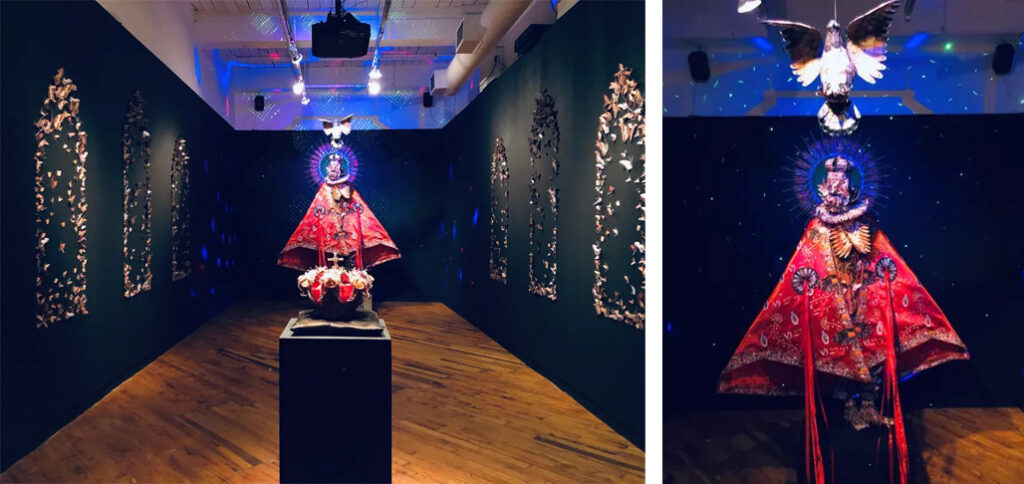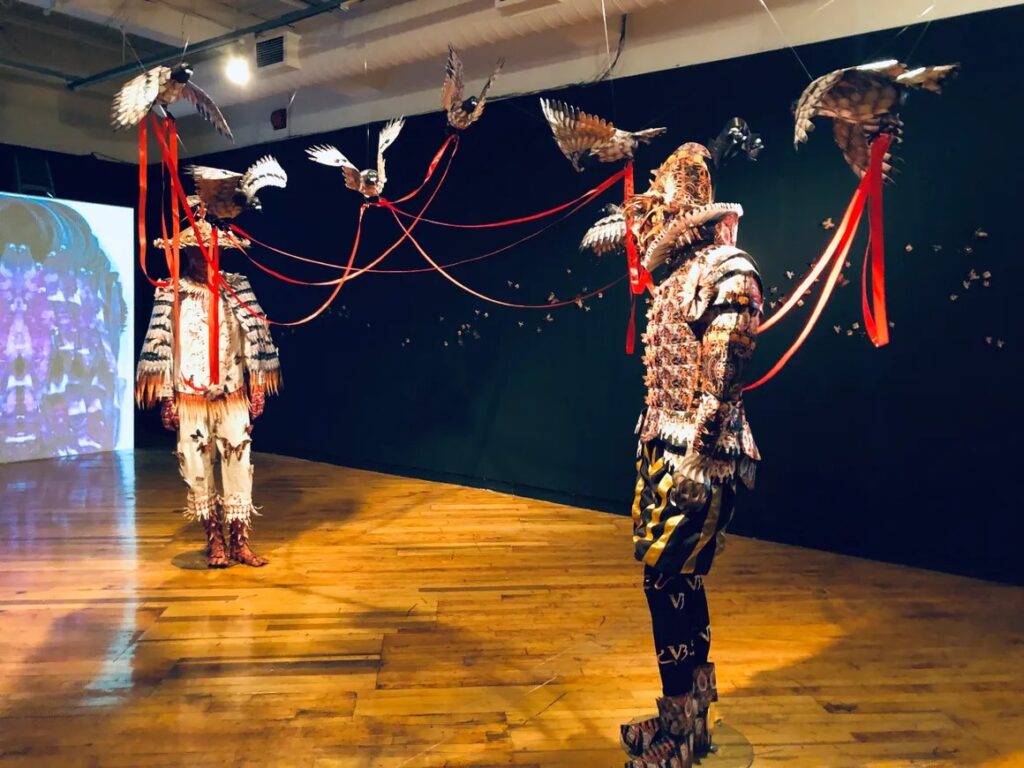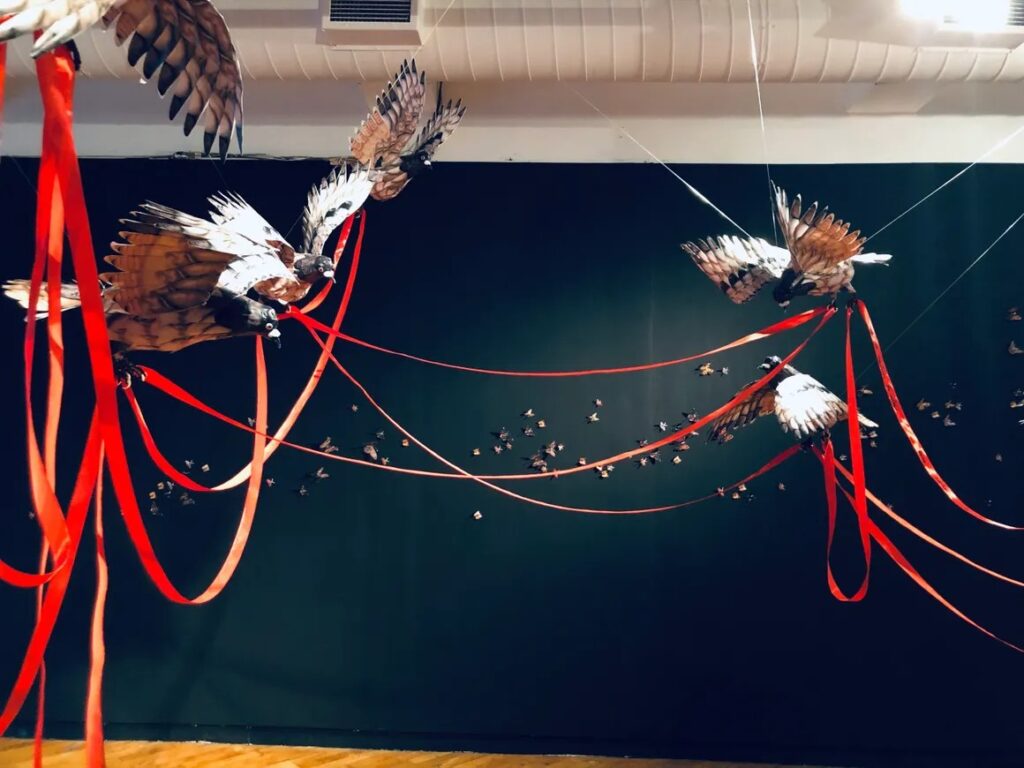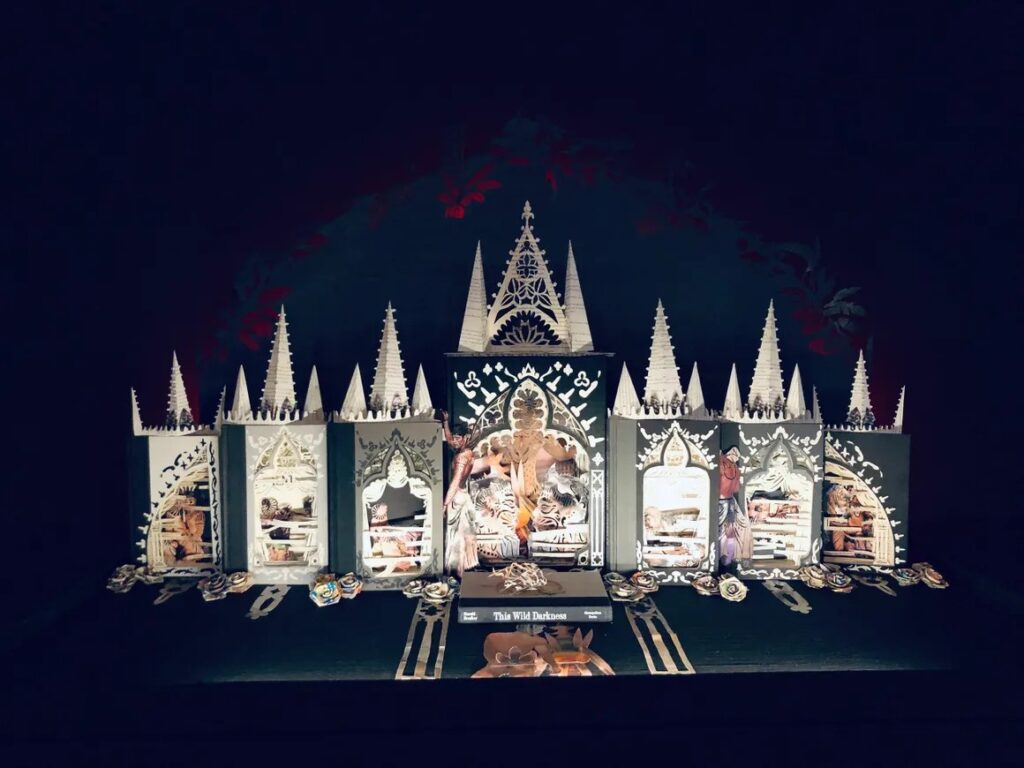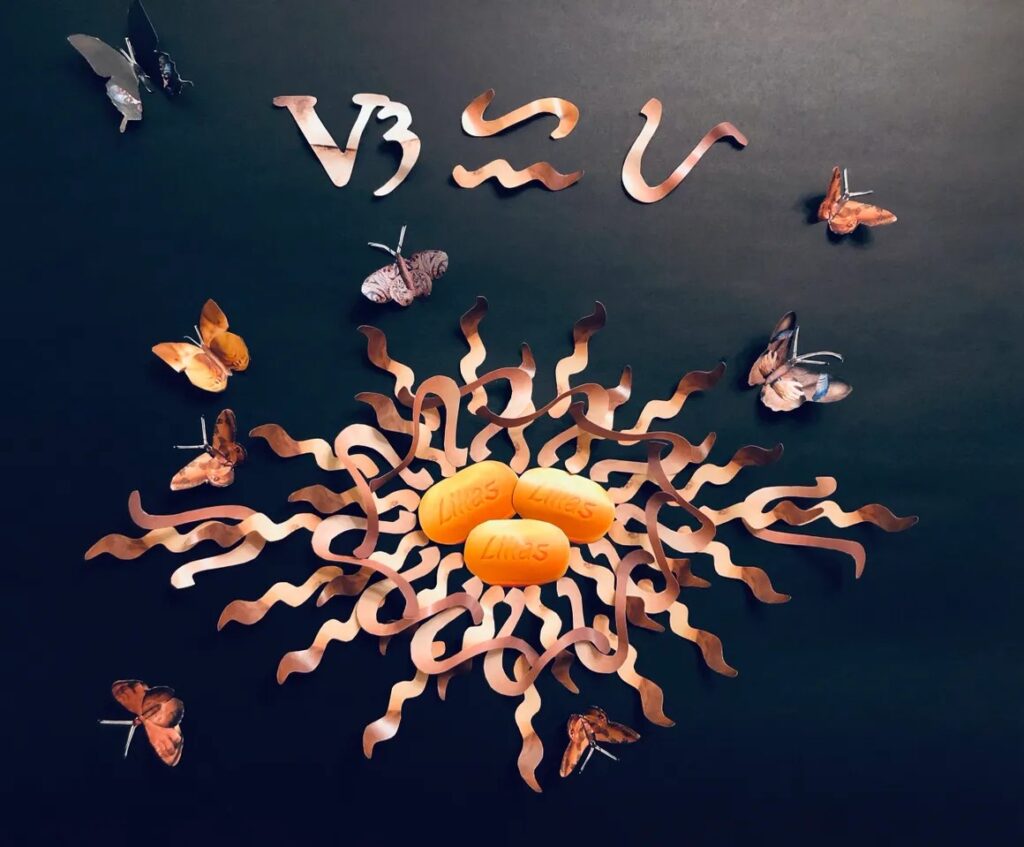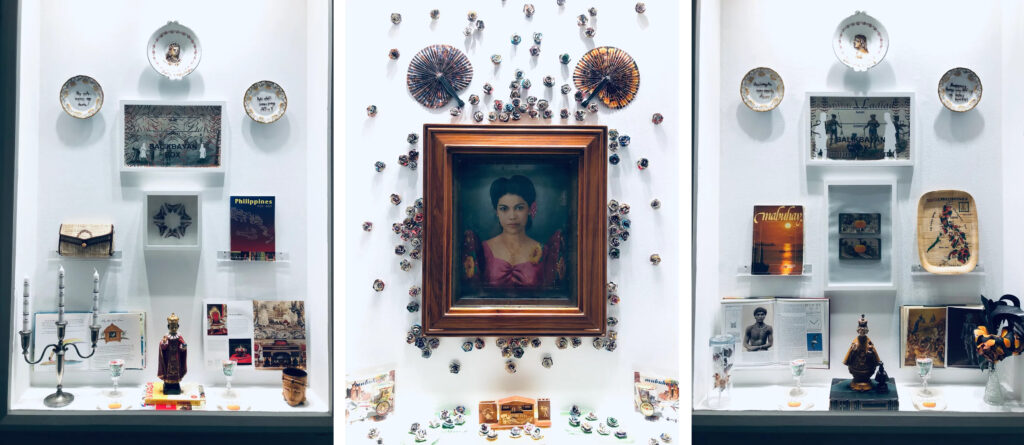Canadian-Filipino artist Julius Poncelet Manapul is an influential queer artist. The exhibition Sila/Siya/Ako is a Tagalog translation of they/them/me. It focuses on the Spanish colonization and how the Catholic religion has influenced the people of Philippines for the last few hundred years. In this exhibition Manapul aims to show the journey of a Filipinx-queer (himself among them) and how they must present themselves in a society that only accepts the masculine white male persona. His work is centered around his personal identity.
Manapul’s staged scene is magnificent. Upon walking into the room, I felt a sense of excitement and energy. I was awe-struck by the creativity and magic involved in producing such funny and unique pieces. It is a beautiful and eloquent exhibition. Julius Poncelet Manapul’s life story, and his latest installation at A Space, let us peak into his personal identity, showing himself as he truly is. I found the work inspirational and motivating, and, as a writer and occasional painter/sketcher, I found the meaning and passion behind it quite mesmerizing and influential.
Installation view of Sila/Siya/Ako at the main gallery of A Space
Manapul has created a theatrical Catholic church-meets-early-Y2K gay dance club in the gallery’s smaller room. This church/club represents the holy trinity: God the Father, the Son, and the Holy Spirit. Religion—and the misuse of it by the Spanish colonizers—became the framework and main theme of the exhibition. The holiday on the third Sunday of January celebrates Santo Nino, and because the ‘holy child’ is genderless, queer people can join the festivities celebrating its holiday, even being able to making fun of the religious norms. In Manapul’s installation the baby Jesus is grown up and wearing a red coat, covered by queer symbols. The windows of the chapel/bar are made of butterflies, another gay motif. The result is a rather strange and challenging juxtaposition of Catholic and queer imagery.
Installation view of Sila/Siya/Ako showing the church/club with the mannequin of the Holy Trinity (left) and the Holy Trinity (right)
The other two mannequins, the Spanish conquistador and the Philippines native, are surrounded by pigeons. The conquistador—a symbol of paternalism and the white knight syndrome—wears an artful replica of King Philip II’s armor but, as the armor is made of paper, it is useless and can no longer protect. Opposite him stands the indios who represents ancestral knowledge and culture. All of the mannequins were designed using hand-crafted paper motifs based on their relation to erotic imagery and Philippine symbols. The accompanying pigeons are made of paper feathers that even go as far as to cover their faces. This is a nod to the controversial Philippine entertainment known as cockfighting or sabong. Two roosters are placed against one another in a pit and bets are placed as to which one will come out on top. This is considered a literal blood sport, and metaphorically speaking it indexes colonial violence.
Installation view of Sila/Siya/Ako with the mannequins of the Philippines native (left) and the Spanish conquistador (right) with pigeons carrying ribbons (in between)
Each pigeon in the exhibition is unique. They give the illusion of flight as they are able to spread their wings. Looking at them I felt a sense of freedom and also longing. The metaphorical meaning of the grey pigeon is persistence, harmony, forgiveness, and freedom. The ribbons the birds carry speak that of, “dumating ka para sakupin ako” (you came to conquer me) and “vine a salvar tu alma” (I came to save your soul). This is a clear representation of the fight for freedom and the power of persistence. There are commonly groups of pigeons seen in plazas, at the front of churches and they often nest on the roofs of those buildings. As someone who makes metaphorical connections to everything, Manapul captured the commonness of the bird while still shown its connection to the exhibition’s religious theme.
Installation view of Sila/Siya/Ako with the pigeons carrying ribbons
The king’s crown is one of my favorite pieces, not only for its artistic beauty but its hidden meaning as well. With the show being an expression of self in relation to religion and imperial power, the gallery’s rooms takes gay dance clubs to a whole new level. It makes the crown a symbol of mockery to the concept of colonialism and where it’s taken them today.
Installation view of Sila/Siya/Ako with crown
There is a folding-altar-like piece that reminds me of fairytales and “Once upon a time…” came to mind. Every country, community, and culture has its own tales that represent them. Manapul uses their themes to further develop the ideas of their journey and even mock those traditional stories. This piece brought me back to my childhood while also giving me a laugh and made me recognize how ironic and linear fairytales truly are.
Installation view of Sila/Siya/Ako
This flower-shaped piece is a representation of the concept of physical appearances. In its center is a particular lotion commonly used in the Philippines to lighten one’s complexion. It draws attention to strict standards from the 16th to 19th century that expected Philippine citizens to have lighter skins and those practices are still common.
Installation view of Sila/Siya/Ako with flower-shaped object with skin lotion in its center
The objects in the windows outside the main gallery are more culture related. They are a collection of curated objects from the past decades, including history books, souvenirs from the Philippines, religious iconography, and Manapul’s own personal archive of items—making them a kind of museum. They are eye-catching objects and looking at them feels like traveling to the country itself, experiencing those items firsthand and getting a chance to see and learn about this different culture.
Views of the windows outside the main gallery
While this time around I wasn’t able to meet the artist, the beauty of this exhibition gave me a gift I will always remember. If you love learning about different cultures while also being mesmerized by stunning artworks go to Sila/Siya/Ako, learn its lesson and enjoy its beauty.
Cassandra Johnson
All images are courtesy of the artist.
*Exhibition information: Julius Poncelet Manapul, Sila/Siya/Ako, January 5 – April 27, 2024, A Space Main Gallery, A Space Windows, 401 Richmond St. W. Toronto. Gallery hours: Tuesday to Friday 11am – 5pm, Saturday 12 – 5pm.

